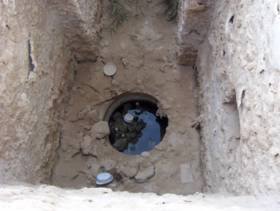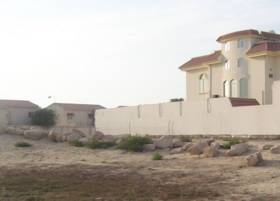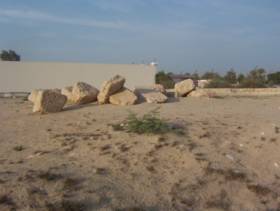The mother of Sujoor
Thursday, November 11, 2004
When they're not trying to restrict our freedoms, our joker MPs are trying to convert historic archaeologic sites in to land for housing. Yesterday's GDN reports:
The proposal was submitted to the services committee by Islamic Bloc chairman and parliament's legislative and legal affairs committee vice-chairman Ali Al Samahiji and Shaikh Jassim Al Saeedi.
Mr Al Samahiji said these lands lie idle after excavations end.
"These lands are useful and could be used for houses other than being used as a dumping ground for the neighbourhood," he said. (Continued)
Somehow, it never occured to these jokers that they could do something to stop these historic sites from being used as dumping grounds, and instead try to preserve what remains.
But it seems that the government has already beaten the MPs to it by several years. One of the sites that I have witnessed as it has sadly deteriorated is the historic 'Ain Umm as Sujoor freshwater spring in Diraz. The well was built way back during the times of the ancient Dilmun civilization, some 4000 years ago. I was trying to find some history about the spring and a bit of googling reveals this fascinating information:
Shaykh Ibraheem al-Mubarak (may Allah have mercy upon him) said in his book “The Past and Present Time of Bahrain”: [...] The famous spring “`Ayn al-Sajoor” which has been dried in the time of Abdil Malik Ibn Marwan, is in this village [Diraz].
During his detailed speech about the story of Abdil Malik Ibn Marwan, the people of Bagrain, and the famous spring “`Ayn al-Sajoor” after his conquering Bahrain, shaykh Yousif [al-Bahrani] (q.s.) added in his Kaskool:
“As for the famous spring “`Ayn al-Sajoor” mentioned in the end of the story; it is located in our village al-Duraaz in Bahrain. It is situated in west of Bahrain, near the shore. The historical excavation showed that this spring was full of water in the past times.
[+/-] show/hide the rest of this excerptThat cursed has ordered his men to fill it with stones and rocks in order to remove it. It remained like that until the time of ruling of the above-mentioned Hajj Yousif son of Nasir (a rich and famous man of Bahrain and a man known for his cleverness in finding underground water). This man who had discovered many springs before, opened a hole in the west side and could bring out water from that spring again. He set up tents round that spring and employed a number of workers who throw away the rocks and stone which were in that spring. It is said that those rocks were very big and heavy that even a hundred men cannot pull one of them.
That cursed brought those rocks from a village near Bahrain called (Jadaa). Hajj Yousif son of Nasir and his workers worked hard and when the water of that spring was about to gush from it, a worker of Hajj Yousif son of Nasir came to him and said: I have seen in a dream that this spring is formed as a woman and she needs a big ox. Hajj Yousif son of Nasir thought that he could be the above-mentioned ox, so he became afraid and sick, then he died after a while, and the well remained as it is until this day. It is said that the worker uttered those words only for a joke and that he aimed that Hajj Yousif son of Nasir make an offering and give him and other workers some meat. Some people of Bahrain used those rocks pulled from that well in building their houses while the rest are still accumulated round the well itself. It is said that tens of people were needed to pull one of those rocks and Allah alone knows best the fact of matters.”
Now, when I was in primary school we went to visit the spring as part of a field trip. Back then, the spring was a small pond. The site had not been maintained, but at least it was untouched, so it was still possible for a visitor to feel its ancient atmosphere. Today unfortunately, the water table has sunk so low that the spring has reduced to this dirty little puddle:


But even more worrying is the encroachment of building on or near the site. A few years back the authorities decided to fence off a portion of the site, and apparently sell off the remaining land. The ancient bricks that happened to be on that land were just chucked in to the fenced portion, so that someone could build a mansion. I hope that the souls of the ancient site will arise from their graves and scare away anyone that tries to build on their land.


But now don't get me wrong; there certainly is a land crisis in Bahrain. However I don't think we should be over-running our history for this sake. If you ask me, I think the Royal Family should sell off some of the huge tracts of unused land that they own around the island. I'm sure that the amount of unused land they own far exceeds the combined space of land taken up by the archaeological sites. And maybe by giving up some land the Royal Family could gain some much needed public popularity.
The following article was printed in the GDN on 10-Nov-04:
'Historical sites for housing' call
Historical sites should be sold for housing once archaeologists have gleaned all they can from them, say MPs.
But Information Minister Nabeel Al Hamer told Parliament yesterday that some sites remained of historical interest, even though initial digs may have been completed.
Archaeological sites are registered with the Information Ministry.
But MPs yesterday agreed to send a proposal to the Cabinet that once finished, they be transferred to the Works and Housing Ministry.
They should then be sold to either the government or private investors for housing, say MPs.
The proposal was submitted to the services committee by Islamic Bloc chairman and parliament's legislative and legal affairs committee vice-chairman Ali Al Samahiji and Shaikh Jassim Al Saeedi.
Mr Al Samahiji said these lands lie idle after excavations end.
"These lands are useful and could be used for houses other than being used as a dumping ground for the neighbourhood," he said.
"We are facing a large population expansion and there are few lands available."
Mr Al Hamer said that the fenced lands were by themselves historical sites reaching back to thousands of years.
"We are still carrying out excavations in these lands and we have allocated some of next year's budget for that purpose," he said.
"Lands which are not needed get transferred to the Municipalities and Agriculture Ministry, which takes care of them."

11/11/2004 05:14:00 pm
Great post Chan'ad,
I'm so happy to see that you've taken time out to really see these abandoned historic sites, that have great stories behind them. The rate things are going, were not going to have any historic sites left. With high land prices, seems the government will bulldoze over every inch of land to make a quick penny under the cover of a land/housing crisis. We seem to quickly forget that the lower half of Bahrain, over 40% of the island is off-bounds for Bahrainis. On the road down to sakheer you eventually reach a NO ENTRY sign. Everyone has forgotton the bottom half of the island. Why are we ruining the environment and reclaiming land at such a fast rate in Northern Bahrain, instead of expanding downwards??? The population density in the upper parts is one of the highest in the world, and in the bottom half probably one of the lowest.
Anyways going back to 3ain um sajoor. I remember being told a story that when Abdulmalik Ibn Marwan (an Umayyad) attacked Bahrain because of their allegience to Imam Ali, they collected all the weapons of the Bahrainis and buried them in the well. When the well was opened up again, (in the Alkhalifa era I think), all these weapons were found. Some are in the museum. But not historical attribution/reference is made to that incident. I will try and get the full story and the details. It would be fascinating to see the weapons used over a thousand years ago by Bahrainis defending this island.
Keep it up. I love reading your posts. And i'll get back to u on Sh. Maythem Albahrani eventually.
Bahrania